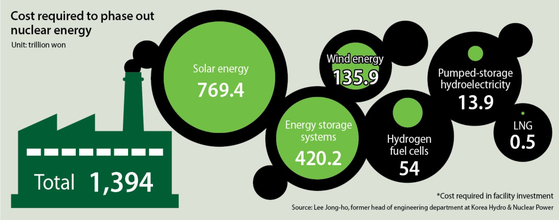Net-zero carbon emissions will cost industry trillions of won
Published: 11 Aug. 2021, 15:55
Updated: 11 Aug. 2021, 19:34

Net-zero carbon by 2050 will come at a hefty price, with some industries spending more than 100 trillion won ($86.5 billion) to dramatically cut emissions.
In order for the petrochemical industry to achieve net-zero carbon emissions in 2050, it will have to spend up to 270 trillion won. The data are based on an internal document from the Korea Petrochemical Industry Association and were released by the office of Rep. Yang Kum-hee of the main opposition People Power Party Tuesday.
For the petrochemical industry, substituting petroleum with something else is a big expense. Petrochemicals refer to chemical products obtained from petroleum by refining. Some chemical compounds can also be obtained from more environmentally-friendly sources like biomass, but the transition is expected to cost the industry 218 trillion won by 2050, according to projections by the Korea Petrochemical Industry Association.
The industry also needs additional funding to increase the use of renewable energy overall in the production process and to upgrade facilities.
Steelmakers are also expected to pay big price to achieve carbon neutrality.
While steelmakers are eyeing hydrogen as a coal alternative in the long-term for the manufacturing process, that transition alone will cost 109.4 trillion won, according to projections by the Korea Iron & Steel Association.
The traditional method of producing steel involves high heat above 1,500 degrees Celsius. In this process, two tons of carbon dioxide is produced for every ton of steel. Burning hydrogen, on the other hand, produces water as a by-product instead of carbon dioxide.
The technology is still in its infancy. The association estimated 2.5 trillion won will be required for research and development of the technology.
As the new production scheme requires new facilities, 35.4 trillion won is expected in renewing the facilities and another 36 trillion won will be needed to scrap the existing facilities by 2050.
A bigger problem is if the local steelmakers fail to commercialize the new technology for mass production in time despite the investment. In such case, they will have to purchase carbon credits to maintain their business. In the worst case scenario that may just be the end of steelmaking business in Korea.
The global steelmakers plan to secure hydrogen-based steelmaking technology by 2040, but no company has yet succeeded in commercialization.
Another option for steelmakers, or any industry that relies on fossil fuel, is to use carbon capture, utilization and storage (CCUS) technology. The process starts by extracting carbon dioxide from the gas produced from combusting fossil fuel. The carbon is then liquefied and transferred to a storage deep underground or undersea, where it can't harm the environment.
While there are some countries, like the United States, China and Japan, already using the CCUS technology, it is still not yet mature in Korea. One major obstacle for Korea is to find the place to store liquefied carbon dioxide with the country having a very small territory.
"Companies are currently pressured to achieve the carbon neutrality target when they don't yet have the technologies," Rep. Yang said. "It is very likely for companies to refrain from making aggressive investments [at this point.]"
Cost is one thing, but some experts point out that achieving the energy mix the government has planned out for 2050 is almost impossible.
The government had initially said it plans to maintain liquefied natural gas (LNG)-based power generation at over 30 percent of the country's total power generation as it hopes to reduce dependence on nuclear and coal energy.
However, the latest three scenarios on the way to carbon neutrality introduced by the Presidential Committee on Carbon Neutrality say otherwise.
Based on three scenarios unveiled early this month, even under the most conservative option -- keeping net emissions at 25.4 million tons compared to going net zero -- combined power generation from nuclear, coal and LNG is kept below 20 percent, while power generation from renewable energy needs to increase from 6.6 percent in 2020 to 56.6 percent in 2050.
Lee Jong-ho, former head of engineering department at Korea Hydro & Nuclear Power, estimates some 1,394 trillion won will be required in building facilities for renewable energy production by 2050 if the government is determined to keep its policies to phase out nuclear power and depend heavily on renewable energy to cut coal power.
"I was being conservative with my calculations, and the actual cost may be higher," Lee said. "This means the citizens may have to pay twice or three times more on electricity than now."
Despite the massive impact the carbon neutrality policies may have on businesses, there are not enough people on the presidential committee to voice concerns of industries. Among the 77 members of the committee, only four are from the business side, including a senior vice president of Hyundai Motor and heads of associations representing steelmakers, petrochemical companies and cement companies.
"Carbon neutrality is a more urgent and important deal for producers who actually need to cut emissions by injecting investments," said Kim Sang-bong, an economics professor at Hansung University, adding that voices of companies must be reflected before coming up with regulations to slash emissions.
BY KIM NAM-JUN, KIM JEE-HEE [kim.jeehee@joongang.co.kr]










with the Korea JoongAng Daily
To write comments, please log in to one of the accounts.
Standards Board Policy (0/250자)